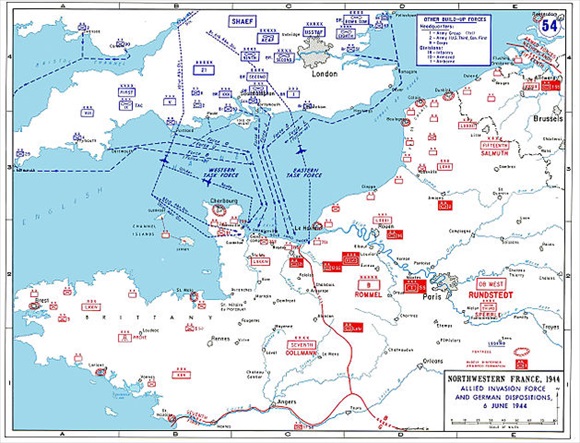| When | June 6 (D-Day) to August 25, 1944 |
| Where | The coast of Normandy, France, stretching from the east coast of the Contentin Peninsula to the west bank of the River Orne. Five invasion beaches: in the east (left flank), the Anglo-Canadian sectors of “Sword,” “Juno,” and “Gold,” and in the west (right flank), two U.S. beaches, “Omaha” and “Utah.” The beaches were “dedicated” so that selected follow-up divisions could land on them. 
|
| Who | Supreme Allied Commander Gen. Dwight D. Eisenhower (1890–1969) commanded the U.S., British, and Canadian forces of Gen. Bernard Law Montgomery’s (1887–1976) Twenty-First Army Group, plus small land, air, and naval components of the Free French. Also underground fighters of the French Resistance, or Maquis. Opposing the Allies was Field Marshal Erwin Rommel’s (1891–1944) Army Group B, consisting of the German 7th and 15th armies. (Ironically, Rommel was in Germany celebrating his wife’s birthday at the time of the Allied landings.) |
| What | The largest amphibious operation in history marked the Western Allies’ return to Northwestern Europe. Total Allied strength: 176,000 troops, 4,000 ships and landing craft, 600 warships, 2,500 heavy bombers, and 7,000 fighter planes. Allied air resources consisted of the U.S. 8th and 9th Air Forces and the British 2nd Tactical Air Force. (Altogether more than a million American soldiers, 124,000 sailors, and 427,000 aviators were involved in Operation Overload.) Total German strength: 850,000 troops, 1,552 tanks, and 800 aircraft. |
| Why | The British and Americans had long intended to return to German-occupied Northern Europe, and Normandy provided suitable beaches within range of England-based air cover. Landings in the south of France in August (Operation Dragoon) were a diversion and an adjunct to Overlord. |
| Outcome | The massive, meticulously planned invasion of Western Europe allowed Allied forces to establish themselves ashore. On D‑Day the Allies flew almost 15,000 air sorties, while the Germans managed only 319. The inability of the enemy to mount a credible counterattack within the first 24 hours meant that Germany had lost the battle for Normandy. The successful landings, materially assisted by French Resistance fighters who disrupted the German response to the Allied invasion, marked a crucial turning point in the war. Hitler’s Third Reich found itself locked in a war of attrition on three fronts (France, Italy, and the Soviet Union) that would overwhelm it in less than a year. |
![]()


 History buffs, there is good news! The Daily Chronicles of World War II is now available as an ebook for $4.99 on Amazon.com. Containing a year’s worth of dated entries from this website, the ebook brings the story of this tumultuous era to life in a compelling, authoritative, and succinct manner. Featuring inventive navigation aids, the ebook enables readers to instantly move forward or backward by month and date to different dated entries. Simple and elegant! Click
History buffs, there is good news! The Daily Chronicles of World War II is now available as an ebook for $4.99 on Amazon.com. Containing a year’s worth of dated entries from this website, the ebook brings the story of this tumultuous era to life in a compelling, authoritative, and succinct manner. Featuring inventive navigation aids, the ebook enables readers to instantly move forward or backward by month and date to different dated entries. Simple and elegant! Click 











